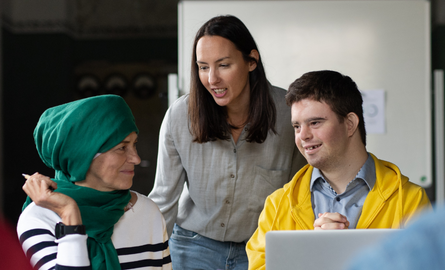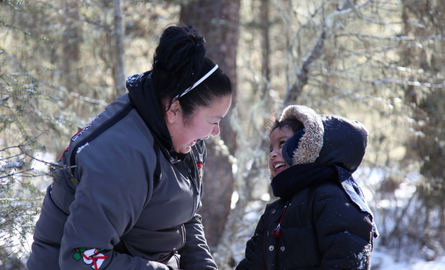If you need help now, contact 9-8-8 or a crisis intervention service.
Suicide affects people of all ages and backgrounds. Eleven people die by suicide every day in Canada. Further, more than 1 in 10 people in Canada have had thoughts of suicide at some point in their lives.
Suicide is a serious and preventable public health problem. Everyone can play a role in preventing suicide by:
- building social connections
- promoting healthy living (e.g., learning and sharing coping skills)
- identifying and supporting those with thoughts of suicide
- promoting strengthened financial supports and stable housing for households in your community
Suicide is often related to complex stressors, health problems, and adverse life experiences. You can help save a life by having the skills to be alert to the signs of suicide and responding with support.

Help is available.
Thoughts of suicide can happen to anyone. Help is available if you, or someone you know, is having thoughts of suicide.
Learn about the mental health services in your area:
If you need help now, contact 9-8-8 or a crisis intervention service.
What are the warning signs? |
|
| There is a broad range of signs someone may be thinking of suicide. A helpful guide of warning signs of suicide spells IS PATH WARM:
I - Ideation: thinking about suicide P - Purposelessness: feeling like there is no purpose in life or reason for living W - Withdrawal: avoiding family, friends, or activities Experiences with thoughts of suicide can vary from person to person and there is no clear checklist for warning signs. Remember, thoughts of suicide can affect anyone regardless of how they present themselves or how their life appears to be from the outside. It is most important to take thoughts of suicide seriously so support can be put in place. |
|
What can I do if I experience thoughts of suicide? |
|
|
|
How can I help a loved one? |
|
|
Common myths about suicide
Myth: It is dangerous to ask someone if they are considering suicide. |
| Fact: Talking about suicide may reduce suicide ideation and prevent suicide. Talking about suicide can improve mental health outcomes and increase the likelihood of the person seeking help. |
Myth: People considering suicide only want to end their life. |
| Fact: A person who attempts suicide does not necessarily want to die, but they do want to end their emotional pain. They may be overwhelmed with hopelessness and unable to see another way out of their situation. It is important to know that thoughts of suicide can pass. People who have thought about or attempted suicide in the past can go on to live full and rich lives. |
Myth: Suicide is a sign of weakness. |
| Fact: Suicide is not weak, selfish, or a cry for attention. These ideas contribute to the stigma that surrounds suicide. Stigma is dangerous and can stop people from seeking help. Talking about suicide is important and can help break down the stigma. |
Suicide-Safe Language
By using language that is suicide-safe, we can help to reduce the stigma around suicide and promote an environment where people can openly and safely talk about suicide. This can help encourage people to get help when they need it.
When talking about suicide, it's important to keep your language clear, factual and neutral.
Examples |
||||||||
|
||||||||
Use person-first language |
||||||||
|
Using person-first language is another way to avoid stigmatizing suicide. It respects people’s identities and experiences, rather than labelling or grouping them. Do say:
Avoid saying:
|
Media guidelines
Media surrounding suicide can be a sensitive topic and lead to suicide exposure effects. Suicide exposure effects can happen when a person is exposed to the details of a death by suicide which leads to suicidal thoughts for themselves. Therefore, it's important for media to follow certain guidelines when reporting on suicide.
Here are some general guidelines to consider:
Do |
|
Avoid |
By following these guidelines, media can report on suicide in a responsible manner that promotes public awareness and support for individuals who may be thinking about suicide. |

You can gain skills to support those around you.
Canadian Mental Health Association North Bay & District offers two types of suicide prevention training:
- safeTALK (suicide alertness for everyone)
- Applied Suicide Intervention Skills Training (ASIST)
Learn more here.

Life promotion is about more than preventing death – it's about equipping young people with the tools and strength to face life’s challenges and live long healthy lives. It is a strengths-based way to restore Hope, Belonging, Meaning, and Purpose among Indigenous youth.
Building on intergenerational resiliency, life promotion focuses on passing down tools and strength through generations and from all relations past and present. It encourages young people to strengthen their connection to land, community, self, and spirit.
Find resources, tools, and teachings in this youth-led resource developed by the Youth Action Group for Life Promotion and the Thunderbird Partnership Foundation:
Strengthening Our Connection to Promote Life: A Life Promotion Toolkit by Indigenous Youth
More Resources
The Centre for Addiction and Mental Health:


